Peltigera
Peltigera is a genus of approximately 91 species of foliose lichens in the family Peltigeraceae.[1] Commonly known as the dog lichen, lichens of Peltigera are often terricolous (growing on soil), but can also occur on moss, trees, rocks, and many other substrates in many parts of the world.[2]
| Peltigera | |
|---|---|
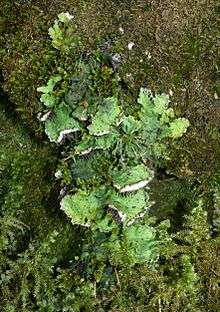 | |
| Peltigera leucophlebia | |
| Scientific classification | |
| Kingdom: | |
| Division: | |
| Class: | |
| Order: | |
| Family: | |
| Genus: | Peltigera |
| Type species | |
| Peltigera canina (L.) Willd. | |
Most Peltigera species have the cyanobacterium Nostoc as the dominant phytobiont but some have the chlorophyte Coccomyxa in which case they also have small gall-like growths containing Nostoc. Because of their ability to fix nitrogen from the atmosphere, such lichens are influential in soil composition and generation.
Description
Species of Peltigera are foliose, with broad lobed thalli. Although the size of the thalli is variable and species-dependent, in some species the thalli can grow quite large, up to 30 cm in diameter.[3] The color of the upper surface may range from drab gray, brown or greenish. Lower surfaces are typically without a cortex (unlike other foliose lichens),[4] and cottony, often with fungal hyphae fused to form a network of veins. The reproductive structures isidia, soredia or lobules may be present in some species.[5]
All species of Peltigera associate with the nitrogen-fixing cyanobacteria Nostoc.[6][7]
Habitat
P. didactyla is a common pioneer species on disturbed soils and nutrient poor grasslands in Western Europe.[8] At Deception Island in the South Shetlands archipelago, P. didactyla was found growing extensively on ash from volcanic eruptions that occurred in the late 1960s and 1970.[9]
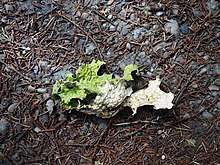
Taxonomy
In 1753, Linnaeus first described the species Lichen apthosus and L. caninus back when all known lichens were grouped into the genus Lichen.[10] Later, in 1787, Willdenow circumscribed the genus Peltigera, and redescribed P. aphthosa and P. canina.[11]
The generic name is derived from the Latin language pelta (small shield), and refers to the shield-shaped thallus in these species. The common name, the dog lichen, refers to the perceived resemblance of P. caninus to a dog.[12]
Phylogeny
In a comparative analysis of both morphological and chemical characteristics as well as sequences of large subunit nuclear ribosomal DNA, it was shown that the genus Peltigera is monophyletic.[13]
Distribution
The Peltigera have a widespread distribution, and are found on all continents. There are 34 North American species, 30 European species, 25 species from South America, and 16 species from New Zealand.[2][3][14][15]
Species
- Peltigera aphthosa
- Peltigera aubertii
- Peltigera britannica
- Peltigera canina
- Peltigera chionophila
- Peltigera cichoracea
- Peltigera cinnamomea
- Peltigera collina
- Peltigera degenii
- Peltigera didactyla
- Peltigera dolichorhiza
- Peltigera dolichospora
- Peltigera elisabethae
- Peltigera erioderma
- Peltigera evansiana
- Peltigera fimbriata
- Peltigera frippii
- Peltigera granulosa
- Peltigera horizontalis
- Peltigera hydrothyria
- Peltigera koponenii
- Peltigera kristinssonii
- Peltigera lambinonii
- Peltigera leucophlebia
- Peltigera malacea
- Peltigera membranacea
- Peltigera montis-wilhelmii
- Peltigera nana
- Peltigera neopolydactyla
- Peltigera occidentalis
- Peltigera oceanica
- Peltigera pacifica
- Peltigera papuana
- Peltigera phyllidiosa
- Peltigera polydactylon
- Peltigera ponojensis
- Peltigera praetextata
- Peltigera retifoveata
- Peltigera rufescens
- Peltigera scabrosa
- Peltigera scabrosella
- Peltigera sumatrana
- Peltigera ulcerata
- Peltigera venosa
- Peltigera weberi
Uses
Peltigera species has been used historically to treat wounds, urinary disorders, thrush, tuberculosis, and rabies.[12][16][17] P. apthosa was used as a remedy for cough[18] and infantile aphthae.[19] P. furfuracea has shown potent antioxidant activity and reducing power.[20] Similarly, Peltigera specimens from Hawaii and Iceland have also been reported to show pronounced antioxidant activity.[21]
Food source
Although a few reports have described caribou and reindeer feeding on the thalli of Peltigera,[22] in general, species of Peltigera are not commonly used as a food source by mammals.[23][24] A study of the grazing habits of the land snails Cantareus aspersa and Limax species revealed that these snails prefer to eat Peltigera species (such as P. praetextata) that are lacking in secondary metabolites.[25]
Bioactive compounds
Peltigera leucophlebia contains the compounds tenuiorin and methyl orsellinate, which are inhibitory to the enzyme 15-lipoxygenase.[26] Tenuiorin is also known to occur in P. apthosa, P. malacea and P. neckeri.[27] A mixture of methyl and ethyl orsellinates have been identified from P. aphthosa that had antibacterial activity against Gram-positive and -negative bacteria.[28] The novel non-protein amino acids solorinine and peltigerine have been detected in various species of Peltigera.[29]
Gallery
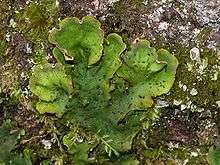
 Peltigera collina
Peltigera collina Peltigera didactyla
Peltigera didactyla Peltigera evansiana
Peltigera evansiana Peltigera horizontalis
Peltigera horizontalis Peltigera hymenina
Peltigera hymenina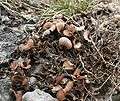 Peltigera hymenina
Peltigera hymenina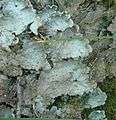

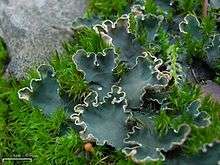
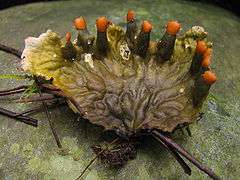
 Peltigera polydactylon
Peltigera polydactylon Peltigera polydactylon
Peltigera polydactylon Peltigera praetaxtata
Peltigera praetaxtata Peltigera rufescens
Peltigera rufescens Peltigera rufescens
Peltigera rufescens
References
- Kirk PM, Cannon PF, Minter DW, Stalpers JA (2008). Dictionary of the Fungi (10th ed.). Wallingford: CABI. p. 504. ISBN 978-0-85199-826-8.
- Martinez I, Burgaz AR, Vitikainen O, Escudero A (2003). "Distribution patterns in the genus Peltigera Willd". Lichenologist. 35 (4): 301–323. doi:10.1016/S0024-2829(03)00041-0.
- Vitikainen O. (1994). (1998). Taxonomic notes on neotropical species of Pelitgera. In: Lichenology in Latin America: history, current knowledge and applications. Edited by M. P. Marcelli, and M.R.D. Seaward. CETESB, Companhia de Tecnologia de Saneamento Ambiental, Estado de Sao Paulo. pp. 135-139.
- Fioliose lichens, Lichen Thallus Types, Allan Silverside
- Geiser, Linda; McCune, Bruce (1997). Macrolichens of the Pacific Northwest. Corvallis: Oregon State University Press. p. 198. ISBN 0-87071-394-9.
- Dodds WK, Gudder DA, Mollenhauer D (1995). "The ecology of Nostoc". Journal of Phycology. 31: 2–18. doi:10.1111/j.0022-3646.1995.00002.x.
- O'Brien HE, Miadlikowska J, Lutzoni F (2005). "Assessing host specialization in symbiotic cyanobacteria associated with four closely related species of the lichen fungus Peltigera". European Journal of Phycology. 40 (4): 363–378. doi:10.1080/09670260500342647.
- Lewis-Smith RI (2005). "Extensive colonization of volcanic ash by an unusual form of Peltigera didactyla at Deception Island, maritime Antarctic". Lichenologist. 37 (4): 367–368. doi:10.1017/s0024282905015252.
- Linnaeus C. (1753). Species plantarum. Stockholm.
- Willdenow 1787
- Sharnoff, Stephen; Brodo, Irwin M.; Sharnoff, Sylvia Duran (2001). Lichens of North America. New Haven, Conn: Yale University Press. ISBN 0-300-08249-5.
- Miadlikowska J, Lutzoni F (2004). "Phylogenetic classification of peltigeralean fungi (Peltigerales, Ascomycota) based on ribosomal RNA small and large subunits" (PDF). American Journal of Botany. 91 (3): 449–464. doi:10.3732/ajb.91.3.449. PMID 21653401.
- Goward T, Goffinet B, Vitikainen O (1995). "Synopsis of the genus Peltigera (lichenized Ascomycetes) in British Columbia, with a key to the North American species". Canadian Journal of Botany. 73: 91–111. doi:10.1139/b95-012.
- Galloway DJ (2000). "The lichen genus Peltigera (Peltigerales:Ascomycota) in New Zealand". Tuhinga. 11: 1–45.
- Negi HR, Kareem A (1996). "Lichens: the unsung heroes". Amruth. 1 (4): 3–6.
- Moerman, Daniel E. (1998). Native American ethnobotany. Portland, Or: Timber Press. ISBN 0-88192-453-9.
- Perez-Llano GA (1944). "Lichens. Their biological and economical significance". Botanical Review. 10: 27–40. doi:10.1007/bf02861799.
- Vartia KO. (1950). On the medicinal use of lichens. Academic dissertation. Helsinki: 11–21.
- Odabasoglu F, Aslan A, Cakir A, et al. (March 2005). "Antioxidant activity, reducing power and total phenolic content of some lichen species". Fitoterapia. 76 (2): 216–9. doi:10.1016/j.fitote.2004.05.012. PMID 15752633.
- Hagiwara K, Wright PR, et al. (March 2015). "Comparative analysis of the antioxidant properties of Icelandic and Hawaiian lichens". Environmental Microbiology. 18 (8): 2319–25. doi:10.1111/1462-2920.12850. PMID 25808912.
- Palmqvist K (2000). "Tansley Review No. 117. Carbon economy in lichens". New Phytologist. 148: 11–36. doi:10.1046/j.1469-8137.2000.00732.x.
- Maser Z, Maser C, Trapper JM (1985). "Food habits of the northern flying squirrel (Glaucomys sabrinus) in Oregon". Canadian Journal of Zoology. 63 (5): 1084–1088. doi:10.1139/z85-162.
- Kallman S (1992). "Wild plants as food during survival situations". Sven Bot Tidsk. 86 (2): 49–52.
- Benesperi R, Tretiach M (2004). "Differential land snail damage to selected species of the lichen genus Peltigera". Biochemical Systematics and Ecology. 32 (2): 127–138. doi:10.1016/S0305-1978(03)00141-8.
- Ingólfsdóttir K, Gudmundsdóttir GF, Ogmundsdóttir HM, Paulus K, Haraldsdóttir S, Kristinsson H, Bauer R (October 2002). "Effects of tenuiorin and methyl orsellinate from the lichen Peltigera leucophlebia on 5-/15-lipoxygenases and proliferation of malignant cell lines in vitro". Phytomedicine. 9 (7): 654–658. doi:10.1078/094471102321616481. PMID 12487331.
- Holtan-Hartwig J (1993). "The lichen genus Peltigera exclusive of the P. canina group, in Norway". Sommerfeltia. 15: 3–77.
- Ingólfsdóttir K, Bloomfield SF, Hylands PJ (1985). "In vitro evaluation of the antimicrobial activity of lichen metabolites as potential preservatives". Antimicrob. Agents Chemother. 28 (2): 289–92. doi:10.1128/aac.28.2.289. PMC 180233. PMID 3834834.
- Matsubara H, Kinoshita Y, Yamamoto Y, Kurokawa T, Yoshimura I, Takahashi K (1999). "Distribution of new quaternary ammonium compounds, solorinine and peltigerine, in the peltigerales". Bryologist. 102 (2): 196–199. doi:10.2307/3244359. JSTOR 3244359.
Further reading
Gilbert, O. Lichens Naturally Scottish. 2004. Scottish Natural Heritage. ISBN 1-85397-373-4